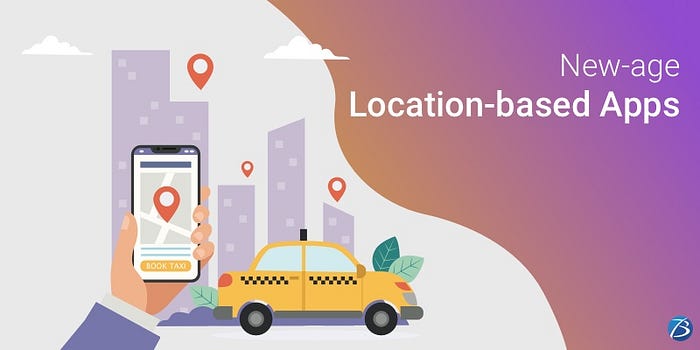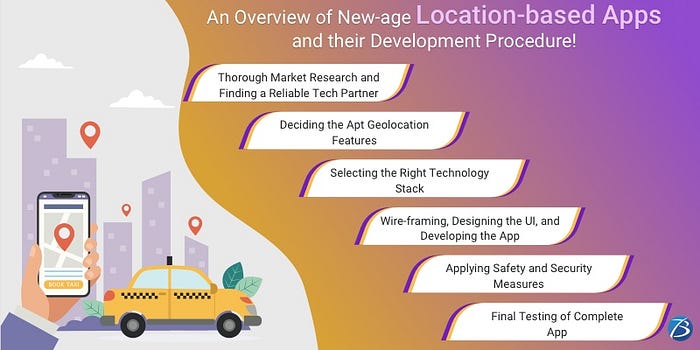ALL >> Computer-Programming >> View Article
An Overview Of New-age Location-based Apps And Their Development Procedure!

Significance of Location-based Applications
Location-Based Services (LBS) are one of the most trending services nowadays. These services are utilized in countless applications like on-demand apps, travel and transportation-related apps, banking apps, social media apps, event planning apps, etc. to name a few. From Instagram to Uber, from Runtastic to Tinder, these apps have impacted millions of peoples’ lives positively. They have eased out several tasks of day-to-day life and made the customer experiences more comfortable.
Here are some top predictions about the location-based services and their applications.
The LBS market is expected to cross $39.2 Billion by the year 2025, as projected by MarketsandMarkets!
Another report by Fortune Business Insights forecasts that by 2026, the LBS market size will cross $66.61 Billion.
It is evident from these stunning reports that the LBS and the location-based apps are high in demand. These are being leveraged by ...
... several entrepreneurs, start-ups, and business enterprises across the globe at a fast pace.
Top Functions of the Location-Based Tracking Apps
Communication: Businesses can register their address or any related places on maps. People can add reviews, leave feedback, and also refer to these reviews. Businesses can even link certain content on the map.
Marketing: Geo-location technologies are used in incentive marketing campaigns for creating interaction mechanics with end-users.
Information: Customers can get real-time information about the location of a person, place or a bus/train, etc.
Major Types of Location-Based Apps using Geolocation Technologies
On-demand Apps like Uber, Zomato, etc.
Social Networking Apps Facebook, WhatsApp, etc.
Location Tracking Apps like Google Maps, Waze, etc.
Dating Apps like OkCupid, Tinder, etc.
eCommerce Apps like Amazon, eBay, etc.
Travel and Tourism Apps like TripAdvisor, Expedia, Booking, etc.
Health and Fitness Apps like MyFitnessPal, Nike Running Club, etc.
Photo Location Finder Apps like Explorest, Google Photos, etc.
Weather Apps like Weather by Apple, Yahoo Weather, etc.
Some of the examples of the location-based apps developed by us are as below:
MastR: This is an eCommerce app that enables customers to do virtual shopping. The product categories displayed are based on the location of the product. It also enables scheduled pickups and deliveries.
BeachCaddy: This app enables end users to request assistance from beach caddies to help them carry beach items. Travel of caddies is tracked through the application.
Otego: It is restaurant management and a food delivery app. Orders placed by the customers can be tracked on the map.
After looking at these live examples of location-based applications, we are now going to discuss the mobile app development process used for creating apps using geo-location technologies. So let’s commence.
How to Create a New-age Location-based App?

Step 1: Thorough Market Research and Finding a Reliable Tech Partner
You should first decide which type of location-based app you want to build by studying its scope in the market. Market research is mandatory to get the answers to questions like-
What is my target audience?
How my app idea will benefit them?
Who are my competitors?
What innovation can I offer to my target audience?
Should I develop an MVP or a full-fledged mobile app?
How to go about the location-based app development process?
Which are the top mobile app development companies and whom can I partner with?
Step 2: Deciding the Apt Geolocation Features
It is essential to integrate some core geolocation features and functionalities in your app to make it highly beneficial to the users. These functionalities include Map view, GPS coordinates, user location detection, location history, route mapping, location-based notifications, etc.
Step 3: Selecting the Right Technology Stack
Selecting the right tech stack for geolocation app development is a necessity. Find below the list of a few set of tools required for location-based apps to choose from:
Web:
HTML5 geolocation API
iOS:
Google Places API
Google Maps API
Google Maps SDK
Core Location API
Apple MapKit
Android:
android.location package
Google Maps API
Mapbox
Google Location Services API
Google Maps Directions API
Google Distance Matrix API
Yandex Maps
MapView class
Open Street Map
Step 4: Wire-framing, Designing the UI, and Developing the App
The next step is creating several visual prototypes of the app that match your app idea/concept. After wire-framing, design a user-friendly and responsive app UI. Now begin with the development of a feature-rich location-based application. Pay attention to detail, and get your app developed by an experienced team.
Step 5: Applying Safety and Security Measures
Ensuring data safety is of paramount importance, especially because location-based apps carry sensitive data. So, consider all the existing legal regulations of different countries you are going to target and strictly adhere to their safety regulations.
Follow the below-given practices too for making your app secure:
Using multi-factor authentication
Using an SSL certificate
Encrypting communications
Using App Transport Security for iOS or Network Security Configuration for Android
Not storing high-importance data on user devices
Encrypting sensitive information with algorithms like RSA or AES-256
Step 6: Final Testing of Complete App
The last step is to carry out rigorous testing of the app. Make sure that the app meets all the code requirements. Test-driven development (TDD) is another effective approach. These will help you reduce the potential bugs, and enhance the app quality.
Final Thoughts
Needless to say, location-based apps are enjoying extreme popularity across diverse industries. Owing to their vast benefits, almost every mobile app development company in the market is utilizing this functionality in some of their apps.
So, do you have a great idea for developing a location-based application? Or do you want to enhance your existing app with this amazing functionality? Reach out to the world-class location-based app development company in Texas, USA, for further assistance.
Add Comment
Computer Programming Articles
1. Google Cloud Platform Tutorial: Step-by-step Introduction To Google CloudAuthor: Tech Point
2. Microsoft Azure Tutorial: A Beginner’s Guide To Cloud Computing With Azure
Author: Tech Point
3. How Thoughtful Web Development Improves User Experience And Business Trust
Author: Ramesh Roy
4. Git Tutorial: A Beginner’s Guide To Version Control And Git Basics
Author: Tech Point
5. Machine Learning Tutorial Explained Simply For Students And Beginners
Author: Tech Point
6. How Ai Is Transforming Logistics Software Development
Author: Chudovo
7. Top Seo Companies In Dubai For 2025
Author: webtek Digital
8. Hadoop Tutorial Step By Step: Learn Hadoop Basics To Advanced Concepts
Author: Tech Point
9. Data Science Tutorial From Scratch: Learn Data Science Step By Step
Author: Tech Point
10. Data Science With Python: Best Computer Course For Career
Author: TCCI - Tririd Computer Coaching Institute
11. Magento Web Development Agency: Empowering Brands With Scalable And Smart E-commerce Solutions
Author: Web Panel Solutions
12. Web Development Course For High-paying Jobs
Author: TCCI - Tririd Computer Coaching Institute
13. Data Structures And Algorithms Classes: Tcci Training
Author: TCCI - Tririd Computer Coaching Institute
14. C & C++ Programming: Strong Logic Training
Author: TCCI - Tririd Computer Coaching Institute
15. Python Challenges For Beginners
Author: Softlogic Systems








